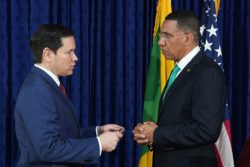Dear Editor,
Monuments do not only freeze images in our minds and help us form opinions about experiences which we have no knowledge of, but they depict the frozen ideas in their creator’s mind of the subject matter being shaped. The 1823 Monument is a glaring example of the mythical and incomplete but popularly approved misconceived image of the Afrikan and Afrikans experience here in Guyana. This lone male larger than life sexist figure, all sinews brandishing a machete is historically inaccurate and symbolically unrepresentative of the Afrikan man, woman, and child, their compassion, sensitivities, heightened moralities, values, ethics and the conviction to represent those values which led to the 1823 revolution.
The antagonists in the 1823 conflict were the captured Afrikans, the protagonists the European planters and the bureaucracy. The arena of conflict, the Afrikans’ human rights. For the Afrikans the medium of conflict resolution was negotiation. That is what they did on Monday night August 18, 1823, when they encountered Governor Murray; that is what they were doing when they were fired upon by Colonel Leahy’s soldiers. Women captured in this kind of conflict are savaged yet the Afrikans were keen to ensure that harm did not come to those women captured. The Afrikan preference for negotiation was met with Leahy’s order to fire on them after they made a call for his arrest; mock trials, Afrikan heads severed from their bodies stuck up on poles along the East Coast and summary execution. In fact the figure standing outside the seawall is more symbolic of Murray and Leahy’s butchery of the Afrikans than the Afrikans’ attempt to negotiate a settlement to their just demands. How Murray and Leahy’s disposition gets transferred to the Afrikans in that monument in modern Guyana is indeed a curiosity.
Aesthetically the monument is good for the area but it is unfortunate that the factual, symbolic and mythological qualities are in direct opposition to its aesthetic values. Its qualities as an educational instrument are likewise compromised. All of these aspects would have been enhanced had the sponsors been careful enough to recognize among others:
a) The seminal role played in the rebellion by Edward, about nine years old, and Isaac about twelve who wrote the letters for Quamina and Jack the leaders of the revolution who could read but not write. That figure standing with chain dangling from hand ignores the important role played by free Afrikans in Demerara like Cato who helped quicken Jack to action by calling him a coward. It ignores too, the role played by women like Susanna cognizant of and working for her own and her children’s freedom, who needled Jack with many an unverified and partly true story of dispatches from London proclaiming the freedom of the Afrikans.
b) That from a point of view of the Afrikan high culture this image is a barbarous monstrosity. It is quite unAfrikan and does not represent the complexity of investigation, planning and organizing which went into 1823. There is a view of the Afrikan, the colonial one, which holds that the Afrikan is devoid of intelligence and as such is incapable of the cognitive skills of analysis, evaluation and synthesis. This strange image does not demonstrate the intelligence gathering on both the local and international levels, and the groundwork done to build consensus for the revolution. The inclusiveness of the decision-making along with the capacity to have kept such an extensive project from the planters’ knowledge until the last minute is a feat in organization and planning. That they were able to execute these skills under the pressure of a slave life attests to the unusual level of collective self discipline and conviction and unity of purpose they possessed.
c) Any story told of the 1823 revolution must bear as a central image of that event the Afrikans’ concern for the preservation of life. That they were willing to kill and capable of doing so but restrained themselves is attested to by the Afrikan Smith who was heard to say to a plantation manager “if it were left to me I would take your head off.” Whether this restraint was to be a bargaining chip or whether they thought that sparing the whites’ lives would have held them in better stead with the Governor as they presented their petition is not known; the fact is that they were particularly cautious in this regard. Non-depiction of this central but unexplainable feature of the revolution must then be a grave misrepresentation of the process.
That there is in Guyanese society a false image of Afrikans is attested to by the article in the August 9 2013 edition of the Guyana Chronicle – ‘Government exposes sinister plot to destabilize the country’; the Chronicle editorial of July 3, 2012 which depict the Afrikan as violent, criminal, responsible for Guyana’s problems and anti-Indian. The monument’s image does nothing to challenge the misconception, in fact its factual and mythological inaccuracies display its erectors’ insensitivities to its potential to perpetuate the ideas contained in the publications listed early in the paragraph. Equally reprehensible is its potential for feeding the uncritical young Afrikan male mind, which may have no countervailing positive images of self, that this empty bravado is the way to go, reinforcing the self-destructive Gaza Gully, sad-man, soldier-man, non-productive, uncultured and uncouth bad man, image beamed at them. That this misrepresentation is sponsored by the national government is irresponsible and reckless. This does nothing to enhance race relations in Guyana as it has the potential to excite unjustified latent fears of Afrikan men.
That depiction by the seawall is more a depiction of the colonial image of the Afrikan than the Afrikans themselves. There is merit in the statement that until the lion tells the story it will always be told from the hunter’s point of view. I hope that the 1823 Coalition tells the lion’s story from the lion’s point of view in its monument. I hope that in depicting the true nature of Afrikan behaviour in the 1823 crisis that they help to correctly educate the nation and contribute to allaying the fears of those who perceive Afrikans to be as presented in that very visible but false image on the seawall. In so doing they will be contributing to help freeze in young Afrikans’ minds a more wholesome image of themselves and their history.
Yours faithfully,
Jonathan Adams








